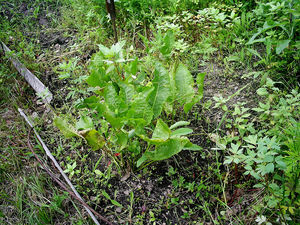Few people eat horseradish right out of the jar. But many people like the taste of bottled horseradish. If you like the taste of bottled horseradish, you’ll really like it fresh. Learn how to harvest, select, prepare, and store horseradish, and pick up a few cooking tips.
Growing Horseradish
Horseradish root has course yellowish-brown skin and is a member of the mustard family. A mature root is about 12 inches long and is shaped like a carrot. The pungent odor is intense and can make your eyes water and your nose run. If you have a cold, it’s a good way to clean out the sinuses. Horseradish is a lot hotter than Japanese wasabe, and homemade horseradish is usually stronger than store-bought horseradish.
Horseradish grows weed-like and doesn’t mind being neglected. It’s invasive, and if you throw it into your garden, you can expect it to overtake it in time. Instead, consider using a container bed to enclose the horseradish and keep it from spreading.
Harvesting Horseradish
Harvest horseradish in late autumn or early spring before new growth occurs. November is a great month to harvest horseradish from your garden or to buy it from a farmer’s market.
To get the root out of the ground, you have to dig it up; you can’t pull it up very easily. And if the top of the root is green and growing, cut off the top and replant it. You could end up with more plants.
Try to use horseradish as soon after cutting as possible. You can store cut roots for a few weeks in the refrigerator, but the longer they are store, the more dry they become. It’s best to use horseradish soon.
Selecting Horseradish
To select a good horseradish root, you need to squeeze the root. It should not be limp or wrinkled. Select a firm, fresh, dense root, with no soft spots or blemishes. When it’s peeled, you’ll know you’ve selected a good one, if the flesh is a creamy white color.
Preparing Horseradish
Never prepare horseradish in a non-ventilated room, and my suggestion is to grate horseradish outdoors. The smell is potent, and you really don’t want to take a strong whiff.
If you’re brave enough to work with horseradish indoors, work near an open window with a fan blowing the odor outdoors. But you do need to know, it will be days before your home is free of the smell of horseradish.
Peel horseradish under water to contain more of the volatile oils. Cut off the end of the root and peel using a strong peeler. Get rid of any woody parts or green tissue before you grate or grind the root.
Basic Horseradish Recipe
To make a batch of grated horseradish, you only need 4 ingredients. You need one firm horseradish root, 2 tablespoons vinegar, a half-teaspoon salt, and 4 tablespoons water. Use canning salt or kosher salt–not iodized salt.
Some recipes call for white distilled vinegar to keep the root looking white. Others use apple cider vinegar for taste and because it’s non-chemical. You decide which one you like. You can also use lemon juice in place of vinegar to keep horseradish from browning. But lemon juice will add its own unique taste. And for another unique taste, some folks like to add parsnips to their horseradish to improve the texture and stretch the taste twice as far.
Grating or Grinding Horseradish
Grate horseradish as you would a potato. If you plan to grate horseradish by hand, wear gloves, and grate it on the finer end of the grater. I recommend using a blender. It’s easier than grating by hand and a lot faster. Don’t handle your horseradish any more than necessary. I recommend gloves.
Cover the blades of your blender with water. If you need a little more than 4 tablespoons, that’s fine; you can always drain it off. Some recipes also call for a bit of crushed ice. I’m not sure why, but it may keep the grind from becoming too fine or the food from sticking between the blades. At any rate, work with only half a blender full at a time.
Slice your peeled horseradish into small chunks, not larger than an inch cubed. In your blender, process the chunks to the consistency of paste. If it’s too fine, you’ll lose some potency as more cells are exposed. Be advised, the moment you bruise or crush the cells of horseradish root, the volatile oils are released. If you want those oils released as you eat the horseradish, keep some texture to your ground mixture.
Browning and Pungency of Horseradish
If you don’t want your horseradish to brown or to become hotter, add your vinegar right after you drain off excess water. If you do want a hotter horseradish, you can wait for not more than 2-3 minutes before adding the vinegar. Vinegar is the acid that stops the enzyme reaction and stabilizes the pungency of the flavor–in addition to halting browning. Some people add vinegar at the beginning, in place of water, but it will stabilize the pungency right at that milder degree of hotness.
When you’re done grinding and you’ve drained off excess water, it’s time to add your vinegar and salt and combine ingredients.
Storing Horseradish
Make your batches in small amounts. One batch can lasts 4-6 weeks in the refrigerator and longer in the freezer. But it will eventually brown and lose some of its bite, the longer you store it. Age also gives horseradish an off-flavor or bitterness.
After you have finished grinding your horseradish, transfer it to a glass jar, using a rubber spatula. Try not to handle it, unless you’re wearing gloves. Store your horseradish in the refrigerator in jar with a tight-fitting lid. The container you use is important. Store and serve horseradish in glass or ceramic containers or bowls–not in anything silver. It’s been know to tarnish silver.
Using Horseradish
Some common foods that people typically add horseradish to include: cocktail sauce, roast beef sandwiches, corned beef, deviled eggs, potato salad, mayonnaise, avocado, coleslaw, tomato juice, pickles, dip, meatloaf, and soup stock.
You can eat both the root and young leaves; the leaves add a special kick to salads.
Did you know you can also grate horseradish root directly over your food?
Enjoy the taste of fresh horseradish by making your own at home. Grow horseradish in your home garden, harvest it in the wild, or purchase a root or two from your local farmer’s market. The next time you want horseradish, use these tips to make your own homemade horseradish.


